1. D2 Lymphadenectomy
The lymphatic route is the main way that gastric cancer spreads; therefore, lymph node involvement represents the leading prognostic factor after surgery
[1][2][1,2].
D2 lymphadenectomy currently represents the standard procedure for locally advanced gastric cancer
[3][4][3,4]. According to the third and fourth edition of the Japanese guidelines, D2 lymphadenectomy for subtotal gastrectomy defines the surgical removal of stations 1, 3, 4sb, 4d, 5, 6, 7, 8a, 9, 11p, and 12a, while D2 lymphadenectomy for total gastrectomy includes stations 1–7, 8a, 9, 11p, 11d, 10, and 12a
[5][6][5,6]. In the fifth Japanese guidelines
[3], station 10 was excluded in D2 dissection for total gastrectomy, except for tumors located in the upper third of the stomach along the greater curvature. Current guidelines indicate D2 lymphadenectomy in all cN+ or cT2-4 tumors, while indicating D1 dissection (limited to stations 1–6) for cT1a tumors or for differentiated cT1b smaller than 1.5 cm in diameter
[4][7][8][4,7,8].
The optimal extent of lymphadenectomy has been a topic of investigation in the past decades. Adequate lymphadenectomy resulted in four potential clinical benefits: (1) adequate disease staging due to the increased number of nodes retrieved; (2) the removal of potentially metastatic lymph nodes, resulting in increased surgical radicality; (3) a decrease in GC recurrence, especially locoregional; (4) prognostic benefit by potential improvement in long-term survival
[9].
1.1. Adequate Disease Staging Due to the Increased Number of Nodes Retrieved
The radicality of the surgical procedure can be evaluated by the number of harvested lymph nodes. When the number of retrieved nodes is less than 10, it is extremely unlikely that
reswe
archers can adequately determine the truly negative incidence of regional lymph nodes
[10][11][12][10,11,12]. For patients with T1-2 N0 stage, the risk of downstaging with an inadequate number of removed lymph nodes is especially high, therefore underestimating the need for a more radical lymphadenectomy
[12][13][14][15][16][12,13,14,15,16]. Although the American Joint Committee on Cancer (AJCC) does not define a standard threshold for the number of nodes to be considered adequate in assigning an appropriate N stage, 16 has been recommended as the minimum number for adequate lymphadenectomy by the Japanese, Korean and European guidelines
[12][17][18][19][20][21][12,17,18,19,20,21], while 15 has been suggested as the minimum number by British and North American societies
[12][22][23][24][12,22,23,24]. The Italian Research Group for Gastric Cancer (GIRCG), based on data collected from a prospective database of 2822 patients treated in high-volume centers (78% and 53% of cases with more than 15 and 25 removed nodes, respectively), highlighted that overall postoperative mortality was 3.5%, even when including aged patients or advanced stages
[9][25][9,25]. Additionally, an analysis of 40,281 patients, included in the American National Cancer Database for gastric cancer, showed a higher 30-day mortality after >29 nodes were removed (4.3%) compared to a resection of 15–28 nodes and <15 nodes (3.0% and 2.1%, respectively)
[26][27][26,27]. In a recent update from the GIRCG database, which included 6230 patients, a strong correlation between the number of removed and metastatic lymph nodes was observed, with a plateau above 40–50 lymph nodes examined (
Figure 1).
Figure 1.
Scatter plot showing the correlation between the number of removed and metastatic lymph nodes (LN) in GIRCG cohort.
1.2. Removal of Potentially Metastatic Lymph Nodes, Resulting in Increased Surgical Radicality
Removing the involved nodes could improve surgical radicality. The number of positive nodes is a well-established prognostic factor in gastric cancer (
Figure 2). However, the GIRCG experience, similarly to other reports
[28][29][28,29], indicates that the survival probability in patients with the same number of involved nodes is strongly affected by the number of removed nodes (
Figure 3). For instance, the survival probability of patients with three involved nodes is 12% when less than 10 nodes are removed, 26% when 11–15 nodes are removed, and 60% when more than 25 nodes are examined. Similar behavior is observed for other lymph-node positive subgroups, with a plateau above 45 removed lymph nodes. These survival trends may be due to the stage migration, the “Will Rogers phenomenon”, but
reswe
archers strongly believe that the therapeutic effect of extended lymphadenectomy plays a crucial role in prognostic benefit. Furthermore, the removal of potential micrometastasis, even in node-negative patients, could also improve the oncological outcome
[30][31][30,31]. In surgical practice, not only the total number of removed lymph nodes is important, but also the topographic sites of different nodal stations, according to the Japanese Gastric Cancer Association (JGCA) guidelines
[32][33][32,33]. The term “contamination” was used to define over-treatment in a certain group (i.e., when a surgeon dissected two or more lymph node stations which he should not have), while the term “non-compliance” was used to define under-treatment (i.e., when a surgeon did not dissect two or more lymph node stations which he should have). The D2 non-compliance mainly involved nodal stations 10, 11d, and 12a in total gastrectomy and 4sb, 11p, and 12a in subtotal gastrectomy. Contamination mainly consisted of the removal of posterior stations (8p, 12b, 12p) in total gastrectomy and 8p, 11d, 12b, and 12p in subtotal gastrectomy. In previous literature, “standard” lymphadenectomy is usually referred to as the surgical dissection described by the JGCA, while “extended”, “more extended” and “super-extended” refer to D2, D2 plus and D3 dissections, respectively. As mentioned above, the D2 lymphadenectomy is routinely accepted in most international guidelines
[4]. Despite a more extended procedure (D2plus) gaining acceptance among surgeons, D3 seems to fail in obscurity in recent years.
MIn our opinion, more extended lymphadenectomy should be performed in selected cases at risk of metastasis to posterior or para-aortic lymph nodes (PAN), while proximal tumors or diffuse-type tumors are particularly prone to spread to distant nodes and may benefit from both posterior and PAN dissection
[34].
Figure 2. Correlation between the number of metastatic nodes and 5-year overall survival in GIRCG cohort. “N” classification according to the 8th Edition of the AJCC is showed in subgroups.
Figure 3.
Five-year overall survival according to the number of removed nodes in different node positive subgroups, in GIRCG cohort.
1.3. Decrease in Gastric Cancer Recurrence, Especially Locoregional
1.3. Decrease in GC Recurrence, Especially Locoregional
The increase in R0 obtained with extended lymphadenectomy has been associated with a decrease in locoregional tumor recurrence
[9].
1.4. Prognostic Benefit by Potential Improvement in Long-Term Survival
The Dutch trial clearly observed lower loco-regional recurrences, as well as cancer-related mortality in the D2 arm compared to the D1 arm, when considering only long-term mortality without 30-day postoperative mortality
[35][36][35,36]. An Italian trial noted a trend toward statistical significance in survival benefit, when compared lymph node-positive patients who underwent D2 and D1 gastrectomy
[37][38][39][40][37,38,39,40]. The abovementioned evidence is confirmed in a Taiwanese randomized trial, which compared limited and extended lymph node dissection
[41]. On the other hand, the surgical removal of the spleen and the pancreatic tail to achieve stations 10 and 11 strongly affects morbidity and mortality rates
[42].
Key points:
-
D2 lymphadenectomy is the standard surgical treatment with curative intent for advanced gastric cancer.
-
Adequate D2 enables accurate disease staging, reduces the incidence of locoregional recurrences and contributes to an improved long-term survival.
-
Undetectable node metastases are associated with high rates of locoregional recurrence.
2. D2 plus and D3 Lymphadenectomies
Radical surgery results from the balance of two elements: the need to guarantee optimal locoregional control of the disease, and the clinical cost of extensive surgery.
The extent of lymphadenectomy, defined by the amount of lymph nodes and the quality of the harvested stations, is a marker of quality of surgical resection. A Turkish anatomical study, comparing total gastrectomy with extended lymphadenectomy to station 16 on autopsy and in vivo cases, revealed higher numbers of lymph nodes harvested in autopsy cases at stations 10, 11, 12, and 16, but no difference at stations 1, 2, 3, 6, 7, 8, and 9
[43].
D2-plus lymphadenectomy is indicated by Japanese studies only in specific cases
[3][6][3,6]: (i) D2+ station 14v consisting of dissection of superior mesenteric venous lymph nodes for cancer of the distal stomach with metastasis to the station 6 lymph nodes, (ii) D2+ station 13 with dissection of lymph nodes posterior to the pancreas head for cancer invading the duodenum, and (iii) D2+ station 16 with dissection of abdominal aortic lymph nodes for cancer with extensive lymph node involvement.
Historically, the so-called D3 dissection included both PAN (16a2 and 16b1) and “posterior” stations (8p, 12p and 13)
[44]. However, as since the third edition of the Japanese guidelines, routine removal of lymph node stations beyond the standard D2 is no longer indicated; more extended procedures beyond the D2 are now called D2plus.
In a recent trial, the survival analysis indicated similar 3-year outcomes between D2 and D2+ arms, while, among patients with duodenum involvement, the 3-year disease-free survival rate of the D2+ group was higher than the D2 group (61.5% vs. 20%, respectively)
[45].
A closer look at the literature on the definition of “extensive lymph node metastases (ELM)”, however, reveals a number of gaps and shortcomings. In most cases, PAN enlargement without other lateral metastasis is considered ELM. From an anatomical point of view, this definition includes the stations 16a2-b1 (lower end of celiac trunk and upper border of inferior mesenteric artery); in a preoperative radiological examination, a positive (metastatic) PAN found that the longest axis of the lymph node is at least 10 mm. As
rwe
searchers consider the latest RECIST (Response Evaluation Criteria in Solid Tumors), a cut-off of ≥15 mm in the short axis should be analyzed
[46].
ResearcheOur
's experience based on analysis of CT scans found that ≥8 mm in the short axis is the value that
researcherswe should take as suspected of PAN gastric cancer metastases
[47]. The other definition of ELM was proposed by Japan Clinical Oncology Group (JCOG) studies about neoadjuvant treatment with ELM. They proposed to include not only PAN but also bulky nodes (bulky N2), defined as lymphatic tissue with a diameter of ≥3 cm or at least two adjacent nodes of ≥1.5 cm in diameter surrounding the coeliac artery and its branches
[48][49][50][48,49,50]. (
Figure 4) The reason for such a consideration is the inability to perform adequate resection, whereas even in the case of resection, the prognosis remains poor, similar to PAN metastases. In the JCOG0405 trial, survival outcomes were similar in PAN-only metastases as well as bulky N-only, while the worst outcome was for patients presenting metastases in both bulky N2 and PAN (results will be discussed further below)
[48].
Figure 4.
Bulky nodes in 16a2-b1 stations.
In 2006, in fact, the phase III JCOG9501 randomized controlled trial investigated the role of “prophylactic” D2+ para-aortic lymph node dissection (PAND) compared to D2 in locally advanced gastric tumors without clinically evident metastases in the para-aortic area
[51]. (
Figure 5) Prophylactic D2+ PAND did not result in survival improvement, while it was associated with a higher morbidity rate. Therefore, the prophylactic removal of para-aortic lymph node 16a2 and 16b1 stations may not be recommended in all patients. Moreover, “curative” D2+ PAND, i.e., dissection of the para-aortic area in cases of clinically detected lymph nodes, was discouraged due to the rate of poor survival
[52].
Figure 5. Para-Aortic Lymph Node Dissection (PAND): (a) intraoperative view of 16a2 lymph node dissection; (b) 16a2 (upper third), 16b1 (medium third) and 16b2 (lower third) lymph nodes stations. IVC: Inferior Vena Cava, RRA: Right Renal Artery, LRV: Left Renal Vein, AO: Aorta, RSV: Right Spermatic Vein, LN: Lymph Nodes.
The stations 13 (retropancreatic) and 14v (superior mesenteric) are commonly considered the “gatekeepers” of the para-aortic nodes, and their dissection in middle- and lower-third advanced gastric cancer represents an independent prognostic factor when performed by experienced surgeons.
[53][54][55][53,54,55].
The issue of the other “posterior” stations such as 8p and 12p has not been deeply discussed.
ReseaOur
cher's group recently explored the benefit of “posterior” station removal in a large Western cohort undergoing D2plus dissection
[56]. Posterior stations are “regional” nodes in distal tumor locations and expressions of an extensive nodal spread. Interestingly, middle- and lower-third gastric tumors showed a higher trend to metastasize to posterior nodes than the upper-third, whereas for PAN metastases it was the reverse. Only 6.3% of patients had metastases in posterior stations, showing a 5-year survival rate of 17% after adequate lymphadenectomy. Moreover, some retrospective data on D2plus lymphadenectomy showed that a higher probability of long-term survival was achieved in pT3 and pT4a patients with PAN metastasis
[34][57][34,57].
Recent studies from the GIRCG, comparing D2 with D2plus lymphadenectomy in patients who underwent upfront surgery with both prophylactic and curative intents, showed that D2plus offers a better locoregional control in diffuse histotype
[58]. Tumor histology largely affects the surgeon’s choice concerning the extent of lymphadenectomy. A European survey concluded that more extended lymphadenectomy was selected for tumors with Lauren diffuse histotype, even if no nodal metastases were detected on preoperative workup
[59].
More extended lymphadenectomy should only be performed in dedicated high-volume hospitals, due to the high risk of post-operative complications and mortality
[60].
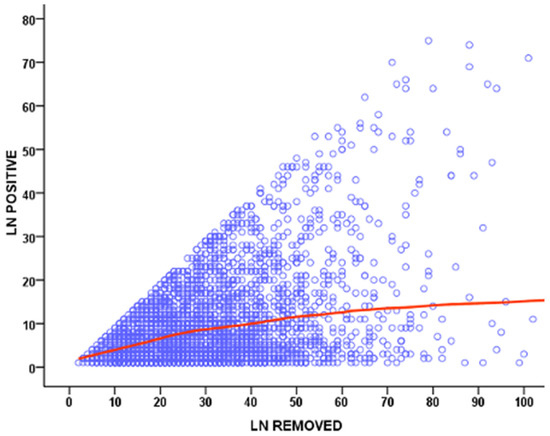
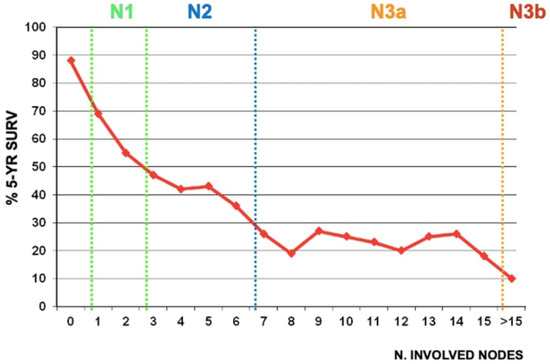
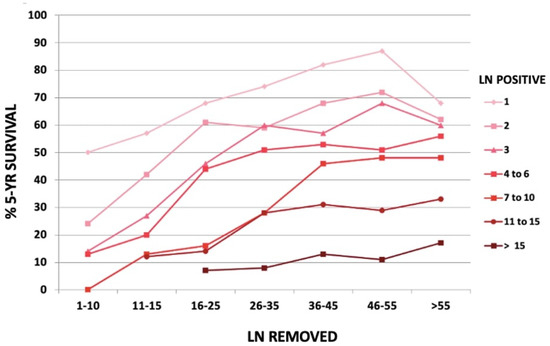
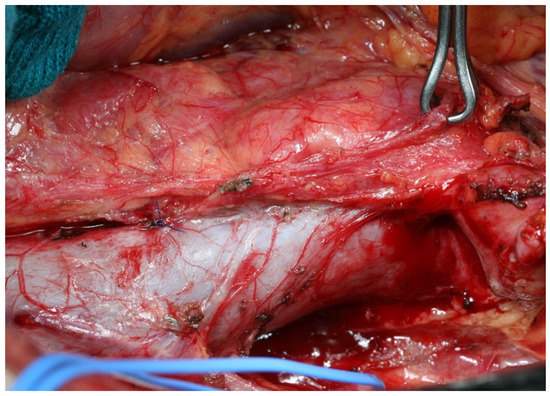
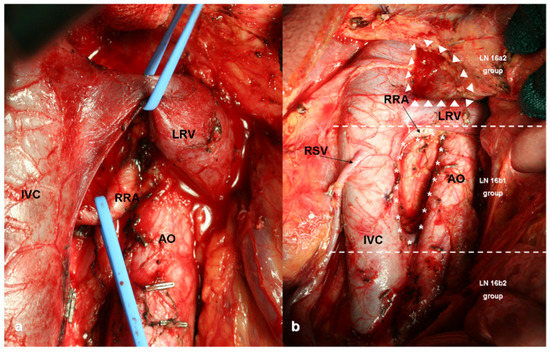
 Encyclopedia
Encyclopedia
